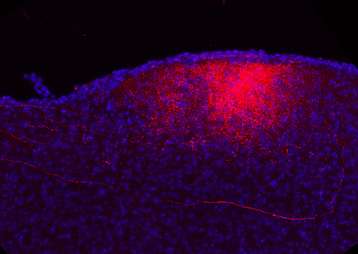Confirmation of the neurobiological origin of attention-deficit disorder

A study, carried out on mice, has just confirmed the neurobiological origin of attention-deficit disorder (ADD), a syndrome whose causes are poorly understood. Researchers from CNRS, the University of Strasbourg and INSERM have identified a cerebral structure, the superior colliculus, where hyperstimulation causes behavior modifications similar to those of some patients who suffer from ADD. Their work also shows noradrenaline accumulation in the affected area, shedding light on this chemical mediator having a role in attention disorders. These results are published in the journal Brain Structure and Function.
Attention-deficit disorder affects between 4-8% of children. It manifests mainly through disturbed attention and verbal and motor impulsiveness, sometimes accompanied by hyperactivity. About 60% of these children still show symptoms in adulthood. No cure exists at this time. The only effective treatment is to administer psychostimulants, but these have substantial side effects, such as dependence. Persistent controversy surrounding the neurobiological origin of this disorder has hindered the development of new treatments.
The study in Strasbourg investigated the behavior of transgenic mice having developmental defects in the superior colliculus. This structure, located in the midbrain, is a sensory hub involved in controlling attention and visual and spatial orientation. The mice studied were characterized by duplicated neuron projections between the superior colliculus and the retina. This anomaly causes visual hyperstimulation and excess noradrenaline in the superior colliculus. The effects of the neurotransmitter noradrenaline, which vary from species to species, are still poorly understood. However, we do know that this noradrenaline imbalance is associated with significant behavioral changes in mice carrying the genetic mutation. By studying them, researchers have observed a loss of inhibition: for example mice hesitate less to penetrate a hostile environment. They have difficulties in understanding relevant information and demonstrate a form of impulsiveness. These symptoms remind us of adult patients suffering from one of the forms of ADD.
Currently, the fundamental work on ADD uses mainly animal models obtained by mutations that disturb dopamine production and transmission pathways. In mice with a malformed superior colliculus, these pathways are intact. The changes occur elsewhere in the neural networks of the midbrain. By broadening the classic boundary used to research its causes, using these new models would allow a more global approach to ADD to be developed. Characterizing the effects of noradrenaline on the superior colliculus more precisely could open the way to innovative therapeutic strategies.
More information: Chantal Mathis, Elise Savier, Jean-Bastien Bott, Daniel Clesse, Nicholas Bevins, Dominique Sage-Ciocca, Karin Geiger, Anaïs Gillet, Alexis Laux-Biehlmann, Yannick Goumon, Adrien Lacaud, Vincent Lelièvre, Christian Kelche, Jean-Christophe Cassel, Frank W. Pfrieger, Michael Reber. "Defective response inhibition and collicular noradrenaline enrichment in mice with duplicated retinotopic map in the superior colliculus." Brain Structure and Function, 2014; DOI: 10.1007/s00429-014-0745-5


















